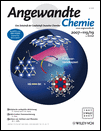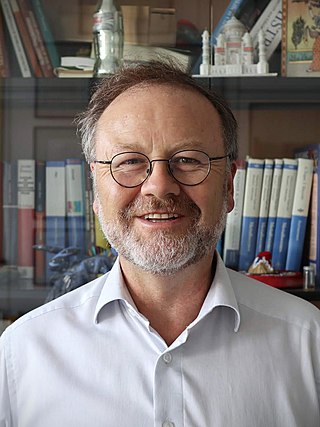Related Research Articles

Angewandte Chemie is a weekly peer-reviewed scientific journal that is published by Wiley-VCH on behalf of the German Chemical Society. Publishing formats include feature-length reviews, short highlights, research communications, minireviews, essays, book reviews, meeting reviews, correspondences, corrections, and obituaries. This journal contains review articles covering all aspects of chemistry. According to the Journal Citation Reports, the journal had a 2021 impact factor of 16.823.
Véronique Gouverneur is the Waynflete Professor of Chemistry at the University of Oxford in the United Kingdom. She also holds a tutorial fellowship at Merton College, Oxford. Her research on fluorine chemistry has received many professional and scholarly awards.
Brigitte Voit is a German chemist and professor of chemistry. She holds the chair Organic Chemistry of Polymers at the Faculty of Chemistry of the TU Dresden and is head of the Institute of Macromolecular Chemistry at the Leibniz Institute of Polymer Research in Dresden. From September 1, 2002 to July 31, 2022 she was also member of the Board of Management/CSO of the IPF Dresden.

Holger Braunschweig is Head and Chair of Inorganic Chemistry at the Julius-Maximilians-University of Würzburg in Würzburg, Germany. He is best known for founding the field of transition metal-boron multiple bonding, the synthesis of the first stable compounds containing boron-boron and boron-oxygen triple bonds, the isolation of the first non-carbon/nitrogen main-group dicarbonyl, and the first fixation of dinitrogen at an element of the p-block of the periodic table. By modifying a strategy pioneered by Prof. Gregory Robinson of the University of Georgia, Braunschweig also discovered the first rational and high-yield synthesis of neutral compounds containing boron-boron double bonds (diborenes). In 2016 Braunschweig isolated the first compounds of beryllium in the oxidation state of zero.
Alexander von Zelewsky was a full Professor in chemistry at the University of Fribourg in Fribourg, Switzerland, from 1969 to 2006.
Christopher Barner-Kowollik FAA, FQA, FRSC, FRACI is an Australian Research Council (ARC) Laureate Fellow, the Deputy Vice-Chancellor Research and Vice-President of the Queensland University of Technology (QUT) and Distinguished Professor within the School of Chemistry and Physics at the Queensland University of Technology (QUT) in Brisbane. He is the Editor-in-Chief of the Royal Society of Chemistry (RSC) journal Polymer Chemistry, a principal investigator within the Soft Matter Materials Laboratory at QUT and associate research group leader at the Karlsruhe Institute of Technology (KIT).
Karl Wieghardt is a German inorganic chemist and emeritus director of the Max Planck Institute for Chemical Energy Conversion in Mülheim. He was active in the preparation and detailed characterization of models for iron and manganese metalloenzymes, metal complexes of noninnocent ligands, and magnetic interactions in polynuclear metal complexes.
Corinna S. Schindler is a Professor of Chemistry at the University of Michigan. She develops catalytic reactions with environmentally benign metals such as iron, towards the synthesis of biologically active small molecules. For her research in the development of new catalysts, Schindler has been honored with several early-career researcher awards including the David and Lucile Packard Foundation Fellowship in 2016, the Alfred P. Sloan Fellowship in 2017, and being named a member of the C&EN Talented 12 in 2017. Schindler has served on the Editorial Board of Organic and Bimolecular Chemistry since 2018.
Stefanie Dehnen is a German chemist. She is the executive director of the Institute of Nanotechnology at the Karlsruhe Institute of Technology. From 2006 to 2022, she was a full professor for inorganic chemistry at the University of Marburg. She has received numerous awards for her research in inorganic chemistry.
Richard Dronskowski is a German chemist and physicist. He is a full professor at the RWTH Aachen University.
Hans Georg von Schnering was a German chemist and professor of inorganic chemistry at the University of Münster, honorary professor at the University of Stuttgart and director at the Max Planck Institute for Solid State Research.
Paul Knochel is a French chemist and a member of the French Academy of Sciences.

Nontrigonal pnictogen compounds refer to tricoordinate trivalent pnictogen compounds that are not of typical trigonal pyramidal molecular geometry. By virtue of their geometric constraint, these compounds exhibit distinct electronic structures and reactivities, which bestow on them potential to provide unique nonmetal platforms for bond cleavage reactions.
Aluminium(I) nucleophiles are a group of inorganic and organometallic nucleophilic compounds containing at least one aluminium metal center in the +1 oxidation state with a lone pair of electrons strongly localized on the aluminium(I) center.
Marilyn Olmstead was an American chemist, an expert in small molecule crystallography and an international leader in the crystallographic study of fullerenes, or "Buckyballs." She held the position of Professor Emerita of Chemistry at the University of California Davis.

Jieping Zhu is an organic chemist specializing in natural product total synthesis and organometallics. He is a professor of chemistry at EPFL and the head of the Laboratory of Synthesis and Natural Products.
Karsten Meyer is a German inorganic chemist and Chair of Inorganic and General Chemistry at the Friedrich-Alexander University of Erlangen-Nürnberg (FAU). His research involves the coordination chemistry of transition metals as well as uranium coordination chemistry, small molecule activation with these coordination complexes, and the synthesis of new chelating ligands. He is the 2017 recipient of the Elhuyar-Goldschmidt Award of the Spanish Royal Society of Chemistry, the Ludwig-Mond Award of the Royal Society of Chemistry, and the L.A. Chugaev Commemorative Medal of the Russian Academy of Sciences, among other awards. He also serves as an Associate Editor of the journal Organometallics since 2014.
An iodide nitride is a mixed anion compound containing both iodide (I−) and nitride ions (N3−). Another name is metalloiodonitrides. They are a subclass of halide nitrides or pnictide halides. Some different kinds include ionic alkali or alkaline earth salts, small clusters where metal atoms surround a nitrogen atom, layered group 4 element 2-dimensional structures, and transition metal nitrido complexes counter-balanced with iodide ions. There is also a family with rare earth elements and nitrogen and sulfur in a cluster.
Carbide bromides are mixed anion compounds containing bromide and carbide anions. Many carbide bromides are cluster compounds, containing on, two or more carbon atoms in a core, surrounded by a layer of metal atoms, encased in a shell of bromide ions. These ions may be shared between clusters to form chains, double chains or layers.
Hermann Schmalzried is a German chemist known for his work in physical chemistry, especially on the thermodynamics and kinetics of solid state chemistry.
References
- 1 2 "HAdW Mitglied". www.haw.uni-heidelberg.de. Retrieved 2018-12-21.
- 1 2 3 4 5 6 7 8 9 10 11 12 13 14 15 16 "Mitgliederverzeichnis". www.leopoldina.org (in German). Retrieved 2018-12-21.
- ↑ "CV Arndt Simon" (PDF). www.fkf.mpg.de. Retrieved 2018-12-21.
- 1 2 Simon, Arndt (1997-07-01). "Group 1 and 2 suboxides and subnitrides — Metals with atomic size holes and tunnels". Coordination Chemistry Reviews. 163: 253–270. doi:10.1016/S0010-8545(97)00013-1. ISSN 0010-8545.
- 1 2 Simon, Arndt (1985-03-15). "Empty, filled, and condensed metal clusters". Journal of Solid State Chemistry. 57 (1): 2–16. doi:10.1016/S0022-4596(85)80055-4. ISSN 0022-4596.
- ↑ Braun, Thomas P.; Simon, Arndt; Böttcher, Fred; Ueno, Fumio (1995). "ATh12N6X29 (A Li…Rb; X Cl, Br): A New Type of Thorium Cluster with a Th12N6 Core". Angewandte Chemie International Edition in English. 34 (5): 567–569. doi:10.1002/anie.199505671. ISSN 1521-3773.
- ↑ Simon, Arndt (1983). "Intermetallic Compounds and the Use of Atomic Radii in Their Description". Angewandte Chemie International Edition in English. 22 (2): 95–113. doi:10.1002/anie.198300951. ISSN 1521-3773.
- ↑ Simon, Arndt (1997). "Superconductivity and Chemistry". Angewandte Chemie International Edition in English. 36 (17): 1788–1806. doi:10.1002/anie.199717881. ISSN 1521-3773.
- ↑ Simon, A. (1970-02-01). "Eine Tieftemperatur-Guinier-Kamera zur Untersuchung luftempfindlicher und bei Raumtemperatur flüssiger Stoffe". Journal of Applied Crystallography (in German). 3 (1): 18–21. doi:10.1107/S0021889870005575. ISSN 0021-8898.
- 1 2 "GDCh-Preise | Gesellschaft Deutscher Chemiker e.V." www.gdch.de (in German). Retrieved 2018-12-21.
- ↑ Communications, Bayer AG. "Bayer AG - Stiftungen". www.bayer-stiftungen.de (in German). Archived from the original on 2018-11-05. Retrieved 2018-12-21.
- ↑ "Leibniz-Preis". www.mpg.de (in German). Retrieved 2018-12-21.
- ↑ "RSC Centenary Prize Previous Winners". www.rsc.org. Retrieved 2018-12-21.
- ↑ "Terrae-Rarae-Preis: A. Simon; NRW-Innovationspreis: S Herres-Pawlis; Albert Einstein World Award of Science: Michael Grätzel". Angewandte Chemie. 124 (19): 4598. 2012. doi:10.1002/ange.201202358. ISSN 1521-3757.
- ↑ "Prof. Dr. rer. nat. Dr. h.c. mult. Arndt Simon : Akademie der Wissenschaften und der Literatur | Mainz". www.adwmainz.de. Retrieved 2018-12-21.
- ↑ "Academy of Europe: Simon Arndt". www.ae-info.org. Retrieved 2018-12-21.
- ↑ "Arndt Simon | Liste des membres de l'Académie des sciences / S | Listes par ordre alphabétique | Listes des membres | Membres | Nous connaître". www.academie-sciences.fr. Retrieved 2018-12-21.